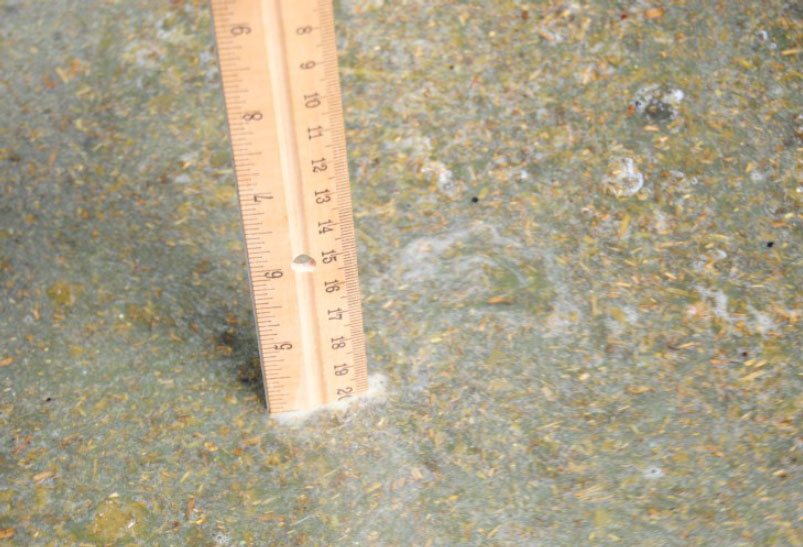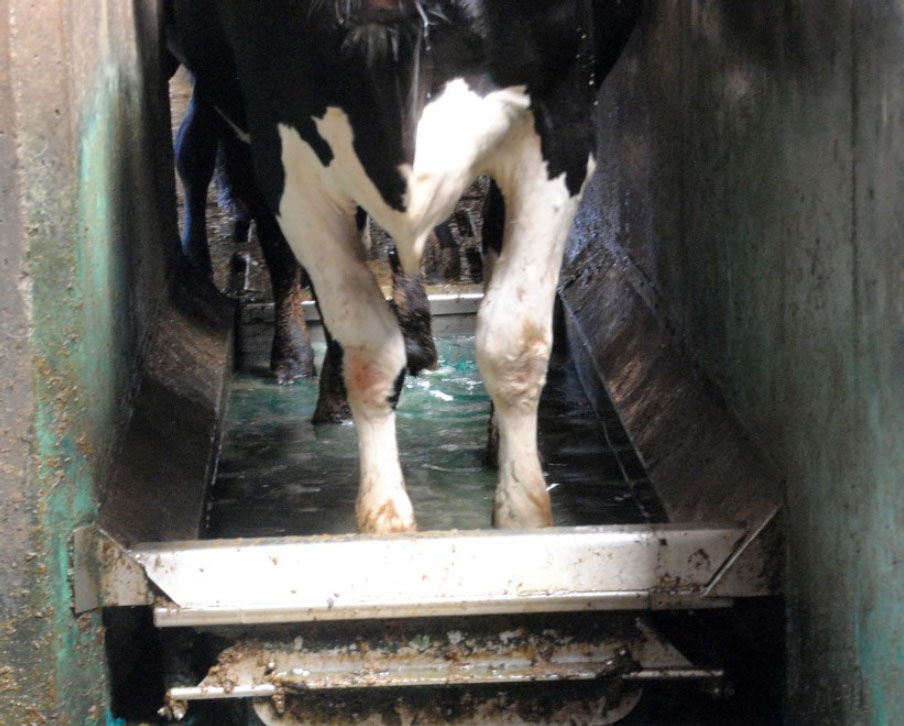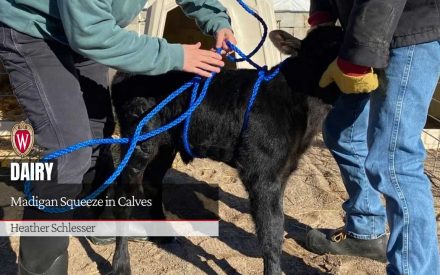English | Español

Introduction
Footbaths are the most commonly used management tool to control Digital Dermatitis (DD) on dairy farms. Proper footbath use will make DD management more effective and save money by reducing the amount of solution used. Footbaths are designed for disinfecting hooves and preventing DD, not for therapy or treatment. Once a cow has DD, she cannot be cured, only managed. However, preventing DD from spreading in a herd can be managed through footbath use. It is recommended that open lesions be detected and topically treated before sending the cow through a footbath. Consult your veterinarian about topical treatment options.
“A one-size fits all footbath protocol does not exist. You need to bring down the prevalence of disease in the herd to a manageable state”
-Dr. Dörte Döpfer, University of Wisconsin School of Veterinary Medicine
The effectiveness of footbaths in preventing infectious lesions is dependent upon a number of factors including footbath solution, frequency of changing solutions, footbath dimensions, footbath placement and animal hygiene.
Footbath sizing and use
Footbaths should be a minimum of 10 feet long so each cow steps in the bath twice with each hoof. Solution depth should be maintained at a minimum of four inches so dewclaws are submerged as the cow passes through. Footbaths can be topped off to maintain at least four inches of depth. Solution concentration should remain at its recommended percentage according to the product label.

(Photo: Aerica Bjurstrom)
Replacing or changing the footbath solution is dependent on hoof and leg hygiene of the cows. Solution should be changed after 150 to 350 cows pass through the footbath. If cows have cleaner hooves and legs, the solution can be changed after 300 to 350 cows have passed through the footbath. If cows have dirty hooves and legs, the solution should be changed more frequently. It is important for you to monitor your individual farm to determine how often changing the solution is best for your herd.
Footbath solution
Footbath solution should be maintained at 3.5—5.5 pH. Making the solution too acidic or too alkaline will not improve DD management results. The skin has a normal pH of 4—5.5, therefore maintaining pH at normal skin level will help maintain healthy skin condition and improve treatment results.
Optimum treatment concentration is not a one-size-fits-all practice. Depending on the type of treatment used, different concentration rates will be utilized.
Copper sulfate solutions are commonly used in footbaths. Copper sulfate’s antibacterial properties help keep the hoof clean, and it also has a hardening effect on the claw horn. The popularity of copper sulfate footbaths can be attributed to both its relatively low cost per animal treated and the common perception among farmers it effectively controls infectious lesions. Research has shown that using copper sulfate footbaths decreases both the incidence and severity of hoof lesions. However, some data suggest that copper sulfate is rapidly neutralized by organic matter, so dirty footbaths will be less effective than clean ones. Copper sulfate concentration is recommended at two to five percent.
Formalin footbaths have many similar effects on hooves as copper sulfate. It kills bacteria, hardens the claw horn, and it is inexpensive. Bacteria do not develop resistance and formalin eventually breaks down into water and carbon dioxide. Research has shown that formalin footbaths reduce incidence and severity of hoof lesions and may retain its antibacterial activity for up to 330 animal passes. Typical formalin treatment concentration is three to five percent.
Using formalin requires additional precautions. Formalin is a suspected carcinogen and must be used in a well-ventilated area and requires additional safety precautions for the person mixing the footbath solution. In addition, formalin may not be effective below 50 degrees Fahrenheit and may slow healing of open claw lesions when treated cattle are required to walk through footbaths. Formalin treatment concentration should be three to five percent. There is evidence demonstrating chemical burns in cattle caused by the use of formalin solutions in excess of five percent.
Zinc sulfate is another acceptable, yet less commonly used footbath solution. While research has not been widely conducted on controlling hoof skin lesions, anecdotal information suggests some success in controlling DD with the use of footbaths containing five to twenty percent zinc sulfate solutions. Like many other footbath solutions, zinc sulfate solutions have antibacterial properties, may also act as a hardening agent and are relatively inexpensive to use in footbaths. Unlike other footbath solutions, zinc sulfate has not been widely accepted because of difficulty dissolving in water. Poor solubility of zinc sulfate has prompted several companies to launch soluble zinc products for footbaths.

Premix solutions have varied concentrations depending on product type. Consult and follow mixing directions exactly as they are recommended. Premix solutions have been formulated and tested for the best results. Determining one’s own concentration rate will not make the product more effective, it could result in hoof damage and cost more to control DD. Visit the University of Wisconsin School of Veterinary Medicine’s Dairyland Initiative website to find the Footbath Dose Calculator. ↗️
Treatment
Treatment frequency will vary depending on the herd. If experiencing an outbreak of DD, treat the herd starting three times a week. Monitor treatment results, and if DD is not improving, increase treatment to four to five times per week. Maintenance footbath treatments can be on a schedule such as Monday-Tuesday-Wednesday or Monday-Wednesday-Friday.
Design your footbath to allow cows to bypass treatment if needed. A simple chlorinated or soapy bath on non-treatment days can be used to manage foot cleanliness.
Footbath solution safety
Review the label and Safety Data Sheet (SDS) for safe use procedures during handling and mixing. If using formaldehyde, review OSHA formaldehyde standard for additional safety requirements.
Include chemicals in your Hazard Communication Program, consisting of inventory, SDS, and Personal Protective Equipment (PPE) selection of farm training procedures.
Train employees in safe mixing and handling, including cleaning the footbaths. In addition, train employees in the use of required PPE. Personal Protective Equipment training should cover proper donning and doffing, as well as cleaning and storage of PPE. Any chemicals requiring an employee to use a respirator, requires a respiratory program in training procedures.
Author

Aerica Bjurstrom
Regional Dairy Educator – Aerica’s work focuses on herd health and animal welfare. She also has a strong background in meat quality and has done programming in market cow carcass quality.
Acknowledgements
- Dr. Dörte Döpfer—University of Wisconsin School of Veterinary Medicine
- Cheryl Skjolaas—University of Wisconsin Center for Agriculture Safety and Health
- Dr. Jan Shearer—Iowa State University
Download Article


 Udder Hygiene Tips That Won’t Stress Your Cow
Udder Hygiene Tips That Won’t Stress Your Cow ▶️ Watch: Confort y diseño de instalaciones en granjas lecheras
▶️ Watch: Confort y diseño de instalaciones en granjas lecheras Madigan Squeeze in Calves
Madigan Squeeze in Calves Consejos de Higiene de la Ubre Que No Estresarán sus Vacas
Consejos de Higiene de la Ubre Que No Estresarán sus Vacas


